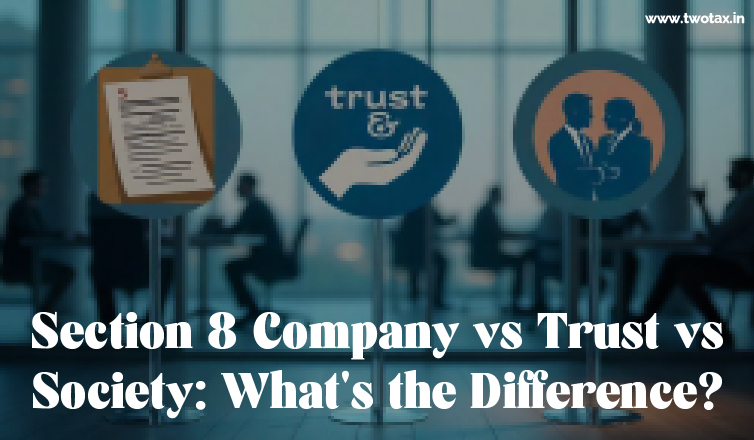Section 8 Company vs Trust vs Society: Detailed Comparison
Confused between Section 8 Company, Trust, and Society? Compare structure, benefits, registration, taxation & real-life examples to choose the best NGO type
By Advocate, Tanvi Thapliyal June 17, 2025
Introduction
Choosing the right legal structure—Section 8 Company, Trust, or Society—is crucial for anyone looking to launch a not-for-profit organization in India. Though all three structures provide a legal framework to address social objectives, they differ significantly in governance, compliance, fundraising, and credibility. This comprehensive guide explores:
-
Definitions & legal frameworks
-
Comparison across key parameters
-
Real-world examples
-
Taxation & audit implications
-
Pros & cons
-
Setting up guidance
-
FAQs
1. Understanding the Basics
A. Section 8 Company
-
Legal Framework: Incorporated under Section 8 of the Companies Act, 2013.
-
Objective: Promotion of commerce, art, science, sports, education, charity, etc., without profit.
-
Governance: Strong regulatory control; board of directors; Articles & Memorandum of Association.
-
Licensing: Requires license from Central Government.
B. Trust
-
Legal Framework: Governed by respective State Trust Acts (e.g., Indian Trusts Act, 1882, and state charity acts).
-
Objective: Promoter/trustees hold property for beneficiaries (charitable or private).
-
Governance: Trustees, no shareholders; trusts deed defines objectives.
-
Licensing: Registration under state trust act; no central license.
C. Society
-
Legal Framework: Registered under the Societies Registration Act, 1860 (for older states) or state society acts.
-
Objective: Promotes literature, science, fine arts, etc.—primarily nonprofit.
-
Governance: Governing council (members); constitution; AGM requirements.
-
Licensing: Registration with state registrar of societies.
2. Head-to-Head Comparison Table
.png)
3. Deeper Comparison
3.1 Legal Identity & Formation
-
Section 8 Company: Incorporated via MCA portal, requiring license, Board resolution, MoA/AoA.
-
Trust: Created on trust deed registration with stamp duty; few approvals needed.
-
Society: Requires minimum 7 members and society bye-laws; state registration process.
3.2 Governance & Operational Control
-
Directors vs Trustees vs Members/Council.
-
Section 8 Companies have formal mechanisms—AGM, EGM, quorum, minutes.
-
Trusts rely on deed and trustee discretion; fewer formalities.
-
Societies: democratic—members elect governing council but risk instability with frequent elections.
3.3 Compliance, Reporting & Audit
Section 8:
-
Annual ROC filings, Board meetings, annual general meeting.
-
Compulsory audit (CA audited financials).
Trust:
-
Audit only if income ≥ ₹10 lakh (threshold varies).
-
Half-yearly returns for public trusts (state variations).
Society:
-
Audit threshold usually income ≥ ₹10 lakh.
-
Annual filing to state registry and mandatory AGMs.
3.4 Fundraising & Credibility
-
Section 8: Highest donor confidence; can issue CSR receipts; easier FCRA.
-
Trust: Good with property donation, real-estate trusts; FCRA possible but compliance-heavy.
-
Society: Popular for NGOs, community groups; FCRA yes but less preferred by large donors.
4. Real-Life Examples
A. Section 8 Company
Teach for India (TFI)
-
Works in education equity; highly structured, corporate style governance.
-
Raises CSR and donor funding, encloses solid financial reporting.
Goonj Foundation
-
Initially a society, later operated through Section 8; recognized for rural development.
Pratham Education Foundation
-
Registered as Section 8; successful in boosting learning in underprivileged schools.
B. Trust
Tata Trusts
-
Among India’s oldest philanthropic trusts; funds health, education, rural development.
Azim Premji Foundation
-
Focused on education reform; assets held in a trust for long-term philanthropic mission.
Bajaj Foundation
-
Trust for community welfare; benefits from flexibility in fund allocation.
C. Society
The Art of Living
-
Registered society promoting cultural/spiritual activities; governing council with large membership base.
Indian Council for Cultural Relations (ICCR)
-
Autonomous society under Ministry of External Affairs; fosters India’s cultural diplomatic outreach.
New India Foundation
-
Society supporting Indian writing in vernacular; grants, fellowships.
5. Taxation & Audits
Tax Exemptions
-
All three can apply under Section 12A for income tax exemption.
-
80G certificates enable donors to claim tax benefits.
-
FCRA is essential for accepting foreign donations.
-
TDS exemptions may apply under certain sections for donations or payments.
Audit Requirements
-
Section 8: Mandatory annual audit by Chartered Accountant.
-
Trust and Society: Audit required if turnover/income > ₹10 lakh (varies by state).
-
Trusts also prepare half-yearly returns (for public charitable trusts).
6. Advantages vs Disadvantages
Section 8 Company
Advantages
-
High credibility with stakeholders
-
Access to CSR & institutional partnerships
-
Legally robust governance
-
Perpetual succession, no change with member changes
Disadvantages
-
Costly setup & renewal
-
Heavy compliance burden
-
Time-consuming licensing and ROC filings
Trust
Advantages
-
Easy & low-cost formation
-
Flexibility in operations
-
Ideal for property-holding & simple philanthropy
Disadvantages
-
Lower transparency and donor confidence
-
Control concentrated in trustees
-
Unclear succession if trustees retire/deceased
Society
Advantages
-
Democratic with member representation
-
Moderate compliance
-
Recognized widely among NGOs
Disadvantages
-
Frequent elections cause instability
-
Less favorable for corporate donors
-
Legal disputes can erupt due to old governing rules
7. Step-by-Step Setup Guide
A. Choose the Right Structure
Ask yourself:
-
Who are your stakeholders? (corporate donors, community, government)
-
How much compliance you’re ready to manage?
-
What’s your long-term vision? (growth, trusts, CSR)
B. Register & Incorporate
Section 8 Company
-
Name approval (SPICe+ form).
-
File MOA/AOA, DINs, DSCs.
-
Apply for Section 8 license (Form INC‑12).
-
Incorporation & PAN, TAN, bank account.
Trust
-
Draft trust deed: name, objectives, settlor, trustees.
-
Register at local sub-registrar with stamp duty.
-
Obtain PAN, open bank account.
-
Annual Apply for 12A, 80G, FCRA (if foreign funds).
Society
-
Prepare bye-laws; minimum 7 members.
-
Get society name; register under Societies Act.
-
Obtain PAN, accounts, open bank account.
-
Register under tax exemption/FCRA.
FAQs
Q1: What is a Section 8 Company?
A Section 8 Company is a nonprofit under Companies Act, seeking promotion of art, education, etc., without profit. It enjoys high credibility but requires regular compliance.
Q2: Can trusts issue 80G certificate?
Yes, both public charitable trusts and societies can register under Section 80G, enabling donors to claim tax deductions.
Q3: Which is better for corporate funding—Trust or Society?
Section 8 Companies are generally preferred by corporate donors due to stricter governance, accountability, and transparency.
Q4: How many members does a society need?
Minimum seven members, who form the founding governing council, with democratic elections thereafter.
Q5: What’s the FCRA requirement?
Any NGO (all three types) wanting foreign funds must register with the Ministry of Home Affairs under FCRA and comply yearly.



.png)